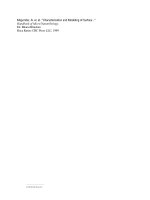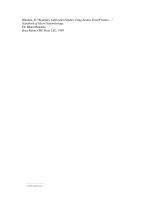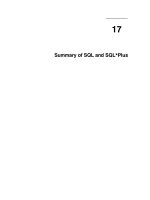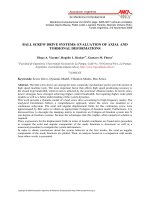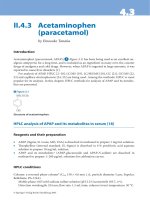INTERNATIONAL HANDBOOK OF LAND AND PROPERTY TAXATION docx
Bạn đang xem bản rút gọn của tài liệu. Xem và tải ngay bản đầy đủ của tài liệu tại đây (1.74 MB, 320 trang )
INTERNATIONAL HANDBOOK OF LAND AND
PROPERTY TAXATION
International Handbook of Land
and Property Taxation
Edited by
Richard M. Bird
University of Toronto
and
Enid Slack
Enid Slack Consulting, Inc.
Edward Elgar
Cheltenham, UK • Northampton, MA, USA
© Richard M. Bird and Enid Slack
All rights reserved. No part of this publication may be reproduced, stored in a
retrieval system or transmitted in any form or by any means, electronic,
mechanical or photocopying, recording, or otherwise without the prior
permission of the publisher.
Published by
Edward Elgar Publishing Limited
Glensanda House
Montpellier Parade
Cheltenham
Glos GL50 1UA
UK
Edward Elgar Publishing, Inc.
136 West Street
Suite 202
Northampton
Massachusetts 01060
USA
A catalogue record for this book
is available from the British Library
ISBN 1 84376 647 7 (cased)
Typeset by Manton Typesetters, Louth, Lincolnshire, UK.
Printed and bound in Great Britain by MPG Books Ltd, Bodmin, Cornwall.
v
Contents
Contributors vii
Acknowledgements viii
1 Introduction and overview 1
Richard M. Bird and Enid Slack
2 Land and property taxation in 25 countries: a comparative review 19
Richard M. Bird and Enid Slack
3 Reforming property taxes 57
Richard M. Bird and Enid Slack
PART I OECD COUNTRIES
4 Property taxation in Canada 69
Enid Slack
5 Property taxation in the United Kingdom 81
Enid Slack
6Property taxation in Australia 91
Enid Slack
7 Land taxation in Germany 98
Paul Bernd Spahn
8 Property tax in Japan 107
Toshiaki Kitazato
PART II ASIA
9 Property taxation in Indonesia 117
Roy Kelly
10 Property taxation in India 129
Gautam Naresh
11 Real property taxation in the Philippines 152
Milwida Guevara
12 Property tax in Thailand 159
Sakon Varanyuwatana
13 Land and property tax in China 165
Xu Shanda and Wang Daoshu
vi Land and property taxation
PART III AFRICA
14 Property taxation in Kenya 177
Roy Kelly
15 Property rates in Tanzania 189
Roy Kelly
16 Property taxation in South Africa 199
Enid Slack
17 Land and property taxation in Guinea 205
François Vaillancourt
18 Land and property taxation in Tunisia 210
François Vaillancourt
PART IV CENTRAL AND EASTERN EUROPE
19 Land-based taxes in Hungary 219
Almos Tassonyi
20 Land and property taxes in Russia 236
Andrey Timofeev
21 Property tax in Ukraine 246
Richard M. Bird
22 Land and property taxes in Poland 253
Richard M. Bird
23 Real estate tax in Latvia 259
Richard M. Bird
PART VLATIN AMERICA
24 Land taxes in Colombia 265
Richard M. Bird
25 Taxes on land and property in Argentina 281
Ernesto Rezk
26 Property tax in Chile 286
Ignacio Irarrazaval
27 Property taxes in Mexico 292
Richard M. Bird
28 Property taxes in Nicaragua 298
Richard M. Bird
Index 303
vii
Contributors*
Richard M. Bird, University of Toronto, Canada
Milwida Guevara, Synergia Foundation, Manila, Philippines
Ignacio Irarrazaval, FOCUS, Santiago, Chile
Roy Kelly, Duke University, Nairobi, Kenya
Toshiaki Kitazato, Research Association for Development of Regional Areas
and Management of Disasters and Crises, Tokyo, Japan
Gautam Naresh, National Institute of Public Finance and Policy, New Delhi,
India
Ernesto Rezk, Universidad Nacional de Córdoba, Argentina
Enid Slack, Enid Slack Consulting Inc., Toronto, Canada
Paul Bernd Spahn, University of Frankfurt, Germany
Almos Tassonyi, Ontario Ministry of Finance, Toronto, Canada
Andrey Timofeev, Georgia State University, Atlanta, USA
François Vaillancourt, Université de Montréal, Canada
Sakon Varanyuwatana, Thammasat University, Bangkok, Thailand
Wang Daoshu, State Administration of Taxation, Beijing, China
Xu Shanda, State Administration of Taxation, Beijing, China
* Affiliation at time of writing.
viii
Acknowledgements
This book originated in a study initially prepared for the World Bank in early
2002 as part of the background work for a report on Land Policies for Growth
and Poverty Reduction, by Klaus Deininger (published for the World Bank by
Oxford University Press, 2003). We are most grateful to Klaus Deininger for
the invitation to take part in this work and for the opportunity to discuss our
initial findings at regional workshops convened by the Bank in Budapest and
Pachuca, Mexico.
We have also benefited greatly both from the comments of discussants at
these workshops and from comments and help received from many other
colleagues around the world: Olga Lucia Acosta, Julio Francisco Baez-Cortes,
Roy Bahl, Nejib Belaid, Jan Brezski, Svetlana Budagovskaya, Zogbelemou
Cece, Klaus Deininger, Joseph Eckert, Istvan Feher, Riël Franzsen, Mark
Gallagher, Marino Henao, Jose Leibovich, Jane Malme, Arthur Mann, Jorge
Martinez-Vazquez, Oliver Oldman, Mudite Priede, Uri Raich, M. Govinda
Rao, Ihor Shpak, Martim Smolka, Laura Sour, John Strasma, Wayne Thirsk,
Bayar Tummenasan, Dana Weist, Christine Wong, Joan Youngman and Juan
Gonzalo Zapata. In addition, Natalia Aristizabal and David Santoyo-Amador
deserve special thanks for their assistance in preparing earlier versions of the
country studies of Colombia and Mexico, respectively.
Our principal debt of course is to those who have contributed country
studies to this book: Milwida Guevara, Ignacio Irarrazaval, Roy Kelly, Toshiaki
Kitazato, Gautam Naresh, Ernesto Rezk, Paul Bernd Spahn, Almos Tassonyi,
Andrey Timofeev, François Vaillancourt, Sakon Varanyuwatana, Wang Daoshu,
and Xu Shanda. Without their efforts, both in preparing the initial country
studies and in updating and revising them for publication, there would be no
book.
Richard M. Bird
Enid Slack
Toronto, September 2003
1
1 Introduction and overview
Richard M. Bird and Enid Slack
Taxes on land and property exist all over the world. In both principle and
practice, these taxes can have important fiscal and non-fiscal effects. The
revenue such taxes produce is often an important source of finance for local
governments. In turn, the extent to which local governments have control
over property taxes is often an important determinant of the extent to which
they are able to make autonomous expenditure decisions. The level, design
and control of property taxation are thus critical elements in effective decen-
tralization policy in many countries. From a more general policy perspective,
land and property taxes may be viewed as either equitable and efficient ways
of raising revenue or regressive and undesirable forms of public finance,
depending upon one’s assumptions, the environment and how exactly the
taxes are designed and applied.
Definitive conclusions on these matters do not emerge easily from an exami-
nation of the complex structure of property taxes around the world. Consider,
for example, the case of Germany, in which two variants of land tax are
imposed on (in effect) four different bases at five different ‘base rates’ which in
turn are modified by locally determined ‘leverage factors.’ Other than noting
that the revenues from this complex set of taxes are small and that reform has
proved politically impossible so far, it is hard to say anything very definite
about the effects of such a system. Germany is not alone in this respect. Taxes
on land and property are among the oldest forms of all taxes. Old taxes need
not necessarily be ‘good taxes,’ as the saying has it, but they almost invariably
have over the years become encrusted with various peculiar features that are
generally difficult to alter and that often obscure their impact.
The case studies that constitute the bulk of this volume make this point
clear. These reviews of the taxation of land and property in 25 countries (five
in each of five regions – OECD, Central and Eastern Europe, Asia, Africa,
and Latin America) focus on the potential contributions of land and property
taxes to the revenues of urban and rural governments and to more efficient
land use. Since the ability of the property tax to make such contributions
largely depends upon the specifics of the tax (tax base, tax rates and adminis-
tration), special attention is paid to such characteristics.
The initial terms of reference given to the authors of all case studies were
to provide information on four basic items: (1) How much revenue is col-
lected from taxes on land and property? (2) What is the tax base, and who
2 Land and property taxation
determines it? (3) What are the tax rates, and who sets them? (4) How is the
tax administered? In addition, authors were asked to provide relevant infor-
mation on other land-based taxes, on the frequency of reassessment, on
differentiations in taxes on types of property, on enforcement and tax arrears,
and so on. Moreover, in each of the five regions noted above, one country –
the first listed in each region (Canada, Hungary, Indonesia, Kenya and
Colombia, respectively) – was selected for a somewhat fuller study of reform
experience. In these cases, authors were asked also to provide some discus-
sion of the rationale, nature and impact of reform efforts.
In total, 15 authors living in 11 countries were involved in preparing
these case studies. The great differences from country to country in both
practices and the availability of information mean that the results presented
here are not uniform from country to country. Some reports are more
detailed and comprehensive than others. Some are more factual; others
more interpretative. Some, especially those from federal countries, focus on
experience in only one part of the country. Some are based on direct
fieldwork; others depend more on existing studies. Some focus almost
entirely on the property tax; others cast their net more widely. Although all
of these case studies were revised and updated by their authors in mid-2003
and have in some cases been further revised by the principal authors of this
book, some important information is still missing in some countries be-
cause it is simply not available.
Table 1.1 sets out some key characteristics of the 25 countries covered in
this book. These countries were selected to cover most regions of the world
and also to some extent to depict different ‘styles’ or practices in taxing land
and real property. Although the sample chosen is not representative in any
statistical sense, and the information obtained is in any case too diverse and
disparate to lend itself to statistical manipulation, many of the conclusions
reached on the basis of this study reinforce those of earlier cross-country
comparative studies of land and property taxes. Some of these earlier studies
focused on developed countries (OECD, 1983), some on transitional coun-
tries (Malme and Youngman, 2001), some on developing countries (Municipal
Development Programme, 1996; Rosengard, 1998), and some have cast their
nets more widely (Youngman and Malme, 1994; McCluskey, 1999; Brown
and Hepworth, 2000; Andelson, 2000). Some studies focused on rural land
taxation (Bird, 1974; Strasma et al., 1987), some on urban property taxes
(Bahl and Linn, 1992), and some on land value taxation as opposed to
property taxation more generally (Andelson, 2000; McCluskey and Franzsen,
2001).
Altogether, the various comparative studies cited cover, to varying degrees,
land and property tax systems in at least 40 countries in addition to those
included in the present book. Moreover, there are, of course, many other
3
Table 1.1 Some key characteristics of case study countries
Country Estimated Area GDP per capita Exchange Central Urban Type of
population (thousand km
2
) (PPP 2002 US$) rate (local government current population government
2003 currency = US$) revenues, 2000 (% total)
(million) (% of GDP)
Australia 19.7 7 687 27 000 1.8406 dollars 23.6 84.7 Federal
Canada 32.2 9 976 29 400 1.5693 dollars 21.8 76.9 Federal
Germany 83.4 357 26 600 1.0626 euros 31.3 87.1 Federal
Japan 127.2 378 28 000 125.388 yen 20.4 78.5 Unitary
UK 60.1 245 25 300 0.6672 pounds 36.0 89.4 Unitary
Hungary 10.1 93 13 300 257.887 forints 37.4 63.6 Unitary
Latvia 2.4 65 8 300 0.6182 lati 28.5 69.0 Unitary
Poland 38.6 313 9 500 3.99 zloty 29.9 64.8 Unitary
Russia 144.5 17 075 9 300 31.2651 rubles 24.6 77.0 Unitary
Ukraine 48.1 604 4 500 5.3266 hryvnia 26.8 67.8 Unitary
Argentina 38.7 2 767 10 200 3.0633 pesos 14.2 89.3 Federal
Chile 15.7 757 10 000 688.953 pesos 22.2 85.2 Unitary
Colombia 41.7 1 139 6 500 2 504.24 pesos 12.6 73.1 Unitary
Mexico 104.9 1 973 9 000 9.656 pesos 14.8 74.0 Federal
Nicaragua 5.1 130 2 500 14.2513 córdobas 31.8 55.5 Unitary
China 1 287.0 9 597 4 400 8.277 yuan 7.2 31.1 Unitary
India 1 050.0 3 288 2 540 48.6103 rupees 12.7 27.8 Federal
Indonesia 234.9 1 919 3 100 9 311.19 rupiahs 18.1 38.8 Unitary
Philippines 84.6 300 4 200 51.63 pesos 15.4 56.8 Unitary
Thailand 64.3 514 6 900 42.9601 baht 16.0 21.0 Federal
Guinea 9.0 246 2 000 1 950.56 francs 11.7 31.4 Unitary
Kenya 31.6 583 1 020 78.7491 shillings 25.8 31.3 Unitary
South Africa 42.8 1 220 10 000 10.5407 rand 26.7 50.0 Federal
Tanzania 35.9 945 630 876.412 shillings – 30.5 Unitary
Tunisia 9.9 164 6 500 1.4217 dinars 28.6 64.1 Unitary
Sources: Central Intelligence Agency, The World Factbook 2003; revenue data and urban share from World Development Indicators, World Bank.
4 Land and property taxation
studies of individual countries, as noted in many of the case studies included
here. On the other hand, some of the countries studied here have not been
covered in earlier studies, and no other study has so systematically attempted
to cover the world.
The diversity in the application of land and property taxes even among the
25 countries covered in this volume is striking. There are differences in the
determination of the tax base, the setting of tax rates, and the ability to levy
and collect the tax. In some countries, one property tax covers all types of
property. In others, there are different taxes for different components of real
property. Countries may, for example, have separate taxes on land and build-
ings; separate taxes on residential and non-residential property; or separate
taxes in urban and rural areas. Moreover, not only are there significant differ-
ences in how land and property are taxed across countries; there are often
significant differences within countries.
The greater the degree of local discretion in establishing the tax base and
setting the rates, the more diversity there is in property taxes within a country.
This is particularly true in federal systems, in which the state or provincial
government often provides the legal framework under which municipalities
can operate. For this reason, or for reasons of information availability, some
case study chapters focus on a specific province or state within the country
and may not provide comprehensive information for the country as a whole.
Indeed, as a general rule, information on local taxes is often surprisingly
difficult to secure and seldom easily comparable even within unitary coun-
tries. Furthermore, although recent reform efforts in a few countries are
discussed, no doubt other reforms are currently under consideration in these
and other countries, so that some of the information included here may
already be obsolete.
For these reasons, a certain degree of modesty is obviously called for with
respect to what is accomplished in this book. Nonetheless, we are aware of
no other recent volume that has attempted to cover the world even to the
limited extent we have achieved here. Complexity, diversity, inadequate and
imperfect information, and change have long been characteristics of property
taxes in many countries. The countries studied here are no exception to this
rule. While we venture some generalizations about land and property taxes in
this and the next two chapters, we are well aware that the devil in land
taxation is in the details, and that the details are often devilishly hard to
determine. Still, the more we know, the better we can understand what details
may be critical in different situations and how best to tackle the ongoing task
of reforming this ancient set of fiscal instruments to cope with the diverse and
changing circumstances of the modern world.
In the balance of this chapter we first place land and property taxes in
context and then summarize a few major conclusions we have drawn from
Introduction and overview 5
this study. In Chapter 2 we present a more detailed comparison of the major
characteristics of land and property taxes in our 25-country sample.
1
Finally,
in Chapter 3 we summarize experience with property tax reform in several of
the countries covered in the book.
The role of the property tax
The property tax as a source of revenue
Tables 1.2 and 1.3 provide a useful introductory overview of the role of the
property tax as a revenue source. Four key conclusions emerge from these
tables and from the Government Finance Statistics (GFS) data that underlie
them:
2
1. Taxes on land and property are at best minor revenue sources in all
countries. For the developing countries included in these tables, for
example, such taxes accounted for only about 0.4 percent of GDP (Table
1.2) and about 2 percent of total tax revenues in the 1990s, down slightly
from earlier decades, although the equivalent share for the OECD coun-
tries remained at a bit more than 1 percent of GDP (Table 1.2) and about
4 percent of all tax revenues throughout the period.
3
2. Nonetheless, as Table 1.3 shows, property taxes are important sources of
subnational revenue in many countries, and more so in developing than in
developed or transition countries. In the 1990s property taxes accounted
for 40 percent of all subnational taxes (rather than the subnational rev-
Table 1.2 Subnational property tax as share of GDP, 1970s–90s (%)
1970s 1980s 1990s
OECD countries 1.24 1.31 1.44
(number of countries) (16) (18) (16)
Developing countries 0.42 0.36 0.42
(number of countries) (20) (27) (23)
Transition countries 0.34 0.59 0.54
(number of countries) (1) (4) (20)
All countries 0.77 0.73 0.75
(number of countries) (37) (49) (58)
Source: Calculated by Roy Bahl and Bayar Tumennasan, Andrew Young School of Public
Policy, Georgia State University, from data in IMF Government Finance Statistics Yearbook,
2001.
6 Land and property taxation
enues shown in Table 1.3) in developing countries, 35 percent (up from 30
percent in earlier decades) in developed countries, but only 12 percent in
transition countries. In the same period, property taxes financed a bit more
than 10 percent of subnational expenditure in developed and developing
countries, although little more than half that much in transition countries.
3. Property taxes are much more important in rich (OECD) countries than
in developing or transition countries. Although these details are not
shown in the tables, for the last year for which all data were available
(1995) the highest property tax to GDP ratio (4.1 percent) was in Canada,
followed by the United States (2.9 percent), and Australia (2.5 percent):
it seems unlikely to be a coincidence that all three are rich federations.
On the other hand, the lowest ratio recorded (0.01 percent) was also in a
rich federal country (Austria), and some developing and transition coun-
tries (South Africa, Latvia) had relatively high (over 1 percent) ratios.
There is clearly more to property tax effort than simply wealth, as we
shall discuss later in connection with Table 1.4.
4. None of the characteristics mentioned above has changed much in recent
decades, with the exception of a relative decline in the importance of
property taxes as a share of subnational revenue (and expenditure) in
developing countries.
Dependence on property taxes as a source of local government revenue
varies across jurisdictions depending upon many factors, such as the expendi-
ture responsibilities assigned to local governments, the other revenues available
Table 1.3 Subnational property tax as share of subnational revenue,
1970s–90s (%)
1970s 1980s 1990s
OECD countries 17.4 17.0 17.9
(number of countries) (16) (17) (16)
Developing countries 27.6 24.3 19.1
(number of countries) (21) (27) (24)
Transition countries 6.7 8.51 8.8
(number of countries) (1) (4) (20)
All countries 22.8 20.4 15.6
(number of countries) (38) (48) (59)
Source: See Table 1.2.
Introduction and overview 7
to them (such as intergovernmental transfers, user fees and other taxes), the
degree of freedom local governments have with respect to property taxation,
the size and growth of the tax base available to them, and their willingness
and ability to enforce such taxes.
The PT/GDP ratio reported in Table 1.2 may be thought of as the product
of the multiplication of a number of other ratios, as follows:
● MV/GDP – the ratio of (market) property values to GDP
● AV/MV – the ratio of assessed base to market values (assessment ratio)
● TV/AV – the ratio of taxable base to assessed base (exemptions)
● T/TV – the ratio of taxes assessed to taxable base (statutory tax rate)
● T*/T – the ratio of taxes collected to taxes assessed (enforcement).
4
Governments can do little directly with respect to the first of these ratios –
although, as noted later, local governments may in some circumstances be
able to affect the share of the potential base that is located within their
jurisdiction. It may be more meaningful to compare property tax collections
not with GDP but rather with (estimated) market values.
This ratio is commonly called the ‘effective rate of property tax’ (ERPT =
T*/MV). In the United States, for example, a recent study found the median
effective rate on a house valued at US$150 000 to be 1.2 percent in 1998.
5
The
same study found the median ERPT on commercial property to be 2.3 percent
and on industrial property to be 1.7 percent. The range from state to state was
impressive, however: with respect to residential property, the estimated state
ERPT ranged from 0.4 percent to 2.9 percent. The range was almost the same
with respect to industrial property (0.4 –3.0 percent), but with respect to com-
mercial property it was considerably greater – 0.7 percent to 6.0 percent.
These numbers suggest two interesting conclusions with respect to the
United States. First, property taxes are generally heavier on non-residential
(and especially commercial) properties than on residential (single-family)
homes.
6
Second, when there is considerable local discretion with respect to
property taxes, as is the case in the United States, there are also likely to be
great differences in effective tax rates. Relatively little information on effec-
tive rates is available for developing and transition countries, but, as discussed
later, both these conclusions seem likely to hold much more widely than just
in the US case. In addition, the ERPT tends to be considerably lower in most
developing countries than noted above for the US. For example, Chapter 11
reports an estimate of 0.07 percent for the Philippines and Chapter 9 shows a
range of between 0.1 and 0.2 percent for Indonesia.
Of course, such numbers do not tell us why effective property taxes are so
low, but it seems likely that all the administrative factors mentioned above
play a role. As noted in Chapter 2, it is clear from the case studies, for
8 Land and property taxation
example, that the assessment ratio is low in many countries. It is also clear
that there are often large exemptions. Moreover, statutory rates are generally
low, and collection efforts poor, as evidenced, for instance, by high arrears
ratios. All these factors seem especially marked in many transition countries
in which in addition land markets are generally not well developed.
As discussed further in Chapter 2, in many – indeed, most – developing
and transition countries, local governments as such have very little scope to
affect many, or in some cases any, of these factors. Although it is often
surprisingly difficult to determine exactly how much ‘autonomy’ local gov-
ernments have in fiscal matters, it appears that in many such countries
assessment, exemption, rates and sometimes even collection are essentially
controlled by higher-level governments.
7
The present and future of subnational
property taxes are thus inextricably related to much broader issues related to
intergovernmental relations and fiscal decentralization more generally.
Table 1.4 Case study countries: property tax effort, 1995
Country Subnational property taxes PT effort
(GFS data) as % of GDP
Australia 2.49 2.03
Canada 4.07 3.51
Germany 1.05 0.39
UK 1.43 0.64
Hungary 0.30 0.89
Poland 1.11 2.20
Russia 1.24 1.45
Argentina 0.92 0.84
Chile 0.61 0.76
Mexico 0.31 0.36
Nicaragua 0.13 1.53
India 0.10 0.84
Indonesia 0.32 1.49
Thailand 0.14 1.65
South Africa 0.65 3.82
Note and source:The second column is a measure of ‘effort’ derived as the ratio of the actual
PT/GDP ratio and the ‘predicted’ ratio based on a regression equation incorporating (in log
form) measures of urbanization, population, per capita GDP and decentralization (measured as
subnational expenditure as a share of total expenditure). The data reported here are a subset of
those reported in Bahl (2001).
Introduction and overview 9
Finally, Table 1.4 reports some results from a recent study by Roy Bahl
(2002) of the factors determining property tax ‘effort’ for, among others,
some of our case study countries.
8
In this study, the PT/GDP ratio is taken to
reflect a number of independent factors – the wealth of the country (as
measured by the level of its per capita GDP), its population and its degree of
urbanization. A regression equation including these variables explains (statis-
tically) about half of the observed variation across countries and suggests that
countries tend to rely more heavily on property taxes as income levels rise
and they become more urbanized.
Another specification of this equation, including also the degree of decen-
tralization (as measured by subnational expenditures as a share of total
government expenditures) as an independent variable, was used by Bahl
(2002) to calculate ‘predicted’ PT ratios for each country. Property tax ‘ef-
fort’ (as shown in Table 1.4) can then be calculated as the ratio of the actual
ratio to the predicted ratio. That is, if a country’s actual ratio is exactly equal
to the ratio predicted, given the values of the independent variables, then the
reported effort would be 1.00. If the actual ratio is greater than the predicted
ratio, effort is greater than 1.00, and so on.
While such calculations are obviously crude, Table 1.4 nonetheless sug-
gests two important conclusions:
● Actual ratios are not a good predictor of effort: some countries (for
example Canada) have both high ratios and high effort; others (for
example the UK) have high ratios but low effort; still others (for
example Nicaragua) have low ratios and – at least by this calculation –
high effort; and, finally, some countries (for example Mexico) have
both low ratios and low effort. How much a country collects in land
and property taxes is not, it seems, a reliable guide to how hard it is
trying to do so.
● On the other hand, it follows from the same information that countries
that make similar efforts may secure very different results (compare,
for example, Germany and Mexico on the low side and Canada and
South Africa on the high side), and, correspondingly, that countries
with similar results (for example Germany and Poland) may be making
very different efforts.
From a policy perspective, what this simple exercise suggests is that while
countries are inevitably constrained in what they can do by environmental
factors, there appears to be considerable leeway for many countries to do
better than they have been doing. Low-effort countries such as Mexico and
Germany, for example, could clearly collect much more in property taxes if
they wanted to do so, although it would be much harder for low-income
10 Land and property taxation
Mexico than for high-income Germany to raise, say, an additional 1 percent
of GDP in such taxes (Bird, 1976). As is so often the case in fiscal matters,
many poor countries could do more than they do in terms of taxing land and
property, but no matter how much they do they are unlikely to reap the same
relative rewards for their effort as more fortunate countries. To them that
hath, it seems, more comes more easily, in this as in other respects.
The property tax as a local tax
The property tax has, historically, been associated with local government in
most countries. One reason that taxes on land and property have been consid-
ered especially appropriate as a local revenue source is that real property is
immovable – it is unable to shift location in response to the tax. Although a
change in property tax may be capitalized into property values in a particular
community, and in the long run tax differentials may affect where people
locate, these effects are of a smaller magnitude than those that would occur
with income and sales taxes at the local level.
Another reason why property taxes are considered to be appropriate as a
source of revenue for local governments is the connection between many of the
services typically funded at the local level and the benefit to property values.
Fischel (2001), for example, has argued that the property tax in the United
States is like a benefit tax because taxes approximate the benefits received from
local services.
To the extent that this is the case, local property tax finance of
local services will promote efficient public decisions since taxpayers will sup-
port those measures for which the benefits exceed the taxes. Both the benefits
derived from such local services as good schools and better access to roads and
transit, and so on and the taxes used to finance such services are capitalized into
property values. Since taxpayers are willing to pay more for better services and
lower tax rates, either will translate into higher property values.
Of course, this analysis is based on a number of assumptions, including the
following:
● Local property taxes in fact finance services that benefit property val-
ues.
● Both tax rates and service levels are decided by local voters.
● Voters who wish to ‘buy’ other combinations of services and tax rates
are free to move to other jurisdictions.
● Voters – impelled by their sensitivity to property values – act rationally
in response to such signals.
● Local governments do what voters want them to do.
The strength and validity of many of these links seem suspect in the context
of many countries. Moreover, this line of argument seems even more tenuous
Introduction and overview 11
when it comes to explaining the generally higher taxation on non-residential
property observed in many countries. Although we shall not discuss this
question further here, as Bird (2003) argues in detail, an income-type value-
added tax appears to be a much more sensible way to ‘price’ local services to
businesses than a property tax.
In contrast to this ‘benefit’ approach, many see the property tax as a tax on
capital or, to the extent it falls on housing, as a tax on housing services.
Zodrow (2001), for example, argues that the property tax in the United States
results in distortions in the housing market and in local fiscal decisions. In
particular, since the US property tax, which is based on market value, falls on
both land and improvements, it both discourages building and results in the
under-utilization of land. The result is that the country ends up with less
capital per unit of land than is economically efficient. Homeowners who
improve their house, for example, will face higher taxes as a result and will
thus be discouraged from doing so. As George ([1879] 1979) said, and as
many others have argued since, a tax on land values alone would avoid this
economic inefficiency and would indeed stimulate the efficient use of land.
We shall return to this point below.
The incidence of the property tax
Who pays the property tax, and is it an equitable tax? There appear to be as
many answers to these questions as there are views about the property tax.
For example:
● Those who view taxes on residential real property as essentially taxes
on housing services tend to think that property taxes are inherently
regressive, since, as a rule, housing constitutes a relatively larger share
of consumption for poorer people.
● Those who view property taxes as essentially a tax on capital tend to
think that such taxes are inherently progressive, since, as a rule, in-
come from capital constitutes a relatively higher share of income for
richer people.
● Those who view the portion of the tax that falls on land as being paid
out of economic rent consider it to be inherently equitable to tax such
‘unearned increments’ arising (often) from public actions.
● Those who view property taxes as essentially benefit taxes tend to
think that there is no more sense in asking if the ‘price’ of local public
services (the property tax) is regressive than in asking if the price
charged for anything else is regressive: voluntary exchange (‘taxes’ –
really generalized user charges – for services) does not, in their view,
raise any question of incidence.
12 Land and property taxation
Although hardly conclusive, the empirical evidence on capitalization on
the one hand and ‘tax exporting’ on the other, at least in the United States and
Canada, suggests that there may be some truth in all of these views.
9
In the
end, it seems, what one beholds in the property tax in terms of equity appears
to depend to a large extent on what one thinks of the property tax in the first
place.
Why property taxes are different
In addition to the obscurity of its incidence, at least four characteristics of the
property tax differentiate it to some extent from other taxes: its visibility, its
inelasticity, its inherent arbitrariness and, in some countries, the extent to
which it reflects local autonomy.
As usually applied, the property tax is a very visible tax. Unlike the
income tax, for example, the property tax is not withheld at source. Unlike
the sales tax, it is not paid in small amounts with each daily purchase.
Instead, the property tax generally has to be paid directly by taxpayers in
periodic lump-sum payments. This means that taxpayers tend often to be
more aware of the property taxes they pay than they are of other taxes.
10
Moreover, to a considerable extent, the property tax finances services
which are also very visible, such as roads, garbage collection and neighborhood
parks. Visibility is clearly desirable from a decision-making perspective be-
cause it makes taxpayers aware of the costs of local public services. This
awareness enhances accountability, which is obviously a good thing from
both an economic (hard budget constraint) and political (democratic) per-
spective. It does not, however, make the property tax popular. On the contrary,
as we discuss further in Chapter 2, it often appears to be harder to raise (or
reform) property taxes than other taxes.
The base of the property tax – no matter which of the bases discussed in
Chapter 2 is employed – is invariably relatively inelastic, meaning that it does
not increase automatically over time. Bahl (2002), for example, notes that the
GDP elasticity of the property tax has been close to unity for decades.
Property values generally respond more slowly to annual changes in eco-
nomic activity than do incomes.
11
Taxable area, of course, responds even
more slowly. Furthermore, as discussed in Chapter 2, few jurisdictions update
property values for taxation purposes on an annual basis.
As a result, in order to maintain property tax revenues in real terms (let
alone to raise property tax revenues), it is necessary to increase the rate of the
tax. As with visibility, inelasticity leads to greater accountability (taxing
authorities have to increase the tax rate to increase tax revenues) but it also
leads to greater taxpayer resistance.
Most taxes are based on flows – income or sales. The tax base may
sometimes be the source of argument between taxpayer and tax authority, but
Introduction and overview 13
there is, in principle, a measurable economic activity on the basis of which
the tax is levied. In contrast, taxes on land and property are (generally) based
on stocks – asset values. Unless the asset subject to tax is sold (by willing
buyers to willing sellers) in the tax period, someone has to determine the
value that serves as the basis on which to assess the tax.
Valuation is inherently and inevitably an arguable matter. If there is a ‘self-
assessment’ system, owners are likely to undervalue their property; if there is
an ‘official’ (cadastral) assessment system, owners are likely to feel that their
property is (at least in relative terms) overvalued. In the end, someone has to
determine the tax base for the property tax in a way that is not true for any
other significant tax. It is not surprising that the results are often perceived to
be unfair and arbitrary. It is also not surprising that the process of obtaining
‘good’ (close to market, fair) valuations is not likely to be cheap. In short, to
administer a property tax at the same level of fairness (non-arbitrariness) as
most other major taxes is both a costly operation and one whose results are
unlikely to be accepted as fair by most taxpayers.
Finally, to the extent property taxes are levied only by local governments,
they obviously act as a major support for local autonomy. The extent to which
such autonomy is either desired or attained is very country-specific. Even in
such countries as Canada and Australia, with important local governments
and important local property taxes, not all taxes on property are levied by
local governments. In some countries, such as Latvia and Chile, the property
tax is much more a central than a local tax. Indeed, if one defines a ‘purely
local’ tax as one in which local governments can (1) decide whether or not to
levy the tax, (2) determine the precise nature of the tax, (3) establish the base
on which to tax individual taxpayers, (4) determine the tax rate, and (5)
enforce the tax, very few countries have such taxes.
As discussed in Chapter 2, in most developing and transition countries,
‘local’ property taxes are, in most of these respects, more ‘central’ than
‘local’ in nature. Since an essential ingredient of responsible local autonomy
– or, if one prefers, of a ‘hard’ subnational budget constraint – is that tax rates
be set locally (and not by a senior level of government),
12
the property tax
systems existing in most countries considered here are still far from achiev-
ing this goal.
An additional result of the lack of local control over property taxes in
Central and Eastern Europe is a disincentive to privatize properties. One
reason many cities in transitional countries are unwilling to dispose of prop-
erties is that they can control the revenue they receive from leasing them, but
they often have no control over property tax revenues. To avoid such distor-
tions, local governments need better control over local tax sources if they are
to get out of the land development business, for which they are generally ill
suited.
14 Land and property taxation
What can property taxes do?
Finance local governments
The property tax generates a significant proportion of local government rev-
enues in a few countries, mainly in the OECD. In most developing and
transition countries, however, the property tax yield provides only a small,
though not insignificant, share of the revenue available for local govern-
ments.
Property tax revenues are low in many developing and transitional econo-
mies in part because of the way in which the tax is administered. As shown in
detail in this book, as a rule the coverage of the tax is not comprehensive,
assessments are low, as are nominal tax rates, and collection rates are also
often low. Low tax rates are sometimes imposed by higher-level governments
and sometimes by local governments themselves, which find rate increases in
this most visible of taxes very difficult to sell politically.
Simply raising the legal tax rate would seldom be considered appropriate,
however, because it would place the burden of the increase on ‘those few
individuals whose properties are on the tax rolls, accurately valued, and from
whom taxes are actually collected’ (Dillinger, 1991, p. 5). Increased nominal
rates are likely to be acceptable only along with such major improvements in
tax structure and administration as more comprehensive coverage, better
assessments, more frequent assessment revaluations and enforced penalties
for late payment.
In general, revenues would be higher if the property tax were based on the
value of land and buildings (instead of just on land), if there were few
exemptions, if there were no favorable treatment of particular property classes,
if the nominal tax rate were set higher, and if the scope for local tax competi-
tion were limited.
Despite its many problems, however, as de Cesare (2002, p. 9) has recently
said, ‘the property tax remains the predominant option for raising revenues
at the local government level in Latin America’ and, it might be added,
elsewhere as well. The potential yield of land and property taxes is unlikely
to be huge, revenues from this source will not be very elastic, and adminis-
trative costs are substantial. Nonetheless, an expanded property tax is indeed
both a logical and a desirable objective for many countries, particularly
those in which local governments are expected to play an increasing role in
allocating public sector resources. But significant additional revenues from
this source can seldom be expected in the short run, and, although property
taxes are usually relatively more important in smaller communities, most
additional revenues will likely be found in, and accrue to, the larger urban
areas.
Introduction and overview 15
Affect land use
The instruments used by local governments to raise revenues can have an
impact on the nature, location and density of development. Local govern-
ments can affect urban form not only with planning tools but also with
municipal financial tools. In some cases, municipal financial tools work
together with planning tools, but in other cases they may have the opposite
effect (Slack, 2002).
The property tax is one fiscal instrument that can clearly influence land use
patterns, especially in urban areas. In terms of the impact on the density of
development, for example, increases in property tax should be expected to
result in a reduction in density (other things being equal). Where the tax is
levied on the assessed value of property (land and improvements), any invest-
ment that increases the value of the property (such as any improvement to the
property including an increase in the density) will increase the assessed value
and make the property subject to a higher tax.
13
Higher property taxes thus
provide an incentive for less densely developed projects – for example, scat-
tered single-family houses rather than apartment buildings. On the other hand,
a tax on land only will provide an incentive for greater density relative to a tax
on both land and improvements. The choice of highest and best use as the tax
base (rather than current use) is also likely to result in higher densities.
It is important to emphasize, however, that to the extent that property tax
differentials are matched by differentials in expenditures on public services,
they should not result in a distortionary impact on location or land use.
Although the property tax cannot be regarded as a direct ‘user fee’ through
which individuals pay directly for the services they receive, where both tax
rates and service levels are determined locally, it can often be thought of
loosely as a benefits tax to the extent that public services provided to the
property-owner enhance the value of the property and result in higher prop-
erty taxes. Where such ‘matching’ does not occur, however, there will be a
pattern of positive and negative subsidies that will influence urban develop-
ment patterns, usually in a way that worsens it. As Oldman et al. (1967)
argued some years ago in the context of an analysis of Mexico City’s fi-
nances, such misallocations are potentially much more damaging in the case
of the rapidly urbanizing cities of the developing world. These concerns seem
still valid today.
In reality, taxes on land and property are seldom matched by service
benefits. For example, non-residential properties are often overtaxed relative
to benefits received compared to residential properties; tax competition among
municipalities often does not reflect differential service benefits; and favorable
tax treatment of farm properties can create distortions.
In summary, a number of policy choices can be made with respect to the
structure of the property tax that will have an impact on land use. Such
16 Land and property taxation
choices include what is included and excluded from the tax base, how prop-
erty value is defined for different classes of property (for example, residential,
farm, commercial and industrial properties), what percentage of the value is
taxable, and how effective tax rates vary within and between classes of
property.
Unfortunately, the information on many of these aspects available in most
countries is inadequate to permit analysis of the effects of the existing –
almost certainly non-optimal – tax systems on land use. Given the very low
effective tax rates currently applied in most countries, the resulting distor-
tions may not be too high. Nonetheless, given current pressures for further
decentralization in many countries and the desirability in most countries of
increased land and property taxation as a source of local finance, it is impor-
tant to ensure that any future property tax reforms take into account not only
the need to be politically acceptable and administratively feasible but also
that the increased taxes be designed properly from an economic perspective.
As argued in Chapter 2, this does not mean that ‘gadgets’ such as land value
increment taxes and progressive land taxes, with their high and perhaps
insuperable political and administrative costs, should play a role. On the
contrary, what it means in most instances is that more attention should be
paid to developing simple, uniform and above all effective local property
taxes, with the only differentiation being perhaps somewhat heavier taxation
of land than of improvements.
Notes
1. An earlier version of much of the material in this and the next two chapters appears in
Bird and Slack (2002).
2. For more data and discussion, see Roy Bahl (2002). We are grateful both to Roy Bahl and
to Bayar Tumennasan for providing these data and for permitting us to make use of their
work.
3. The data in Tables 1.2 and 1.3 do not include taxes on land and property accruing to
central governments. Subnational governments comprise both regional (province, state)
and local (municipal) governments. Since in most countries property taxes basically
accrue to local governments, we shall often simply refer to them as local taxes.
4. This is a variant of the presentation in Bahl (2002). The ratio T*/T may be broken down in
a number of ways. For example, some taxes levied in year 1 may not be collected in that
year – arrears. On the other hand, some taxes collected in year 1 may pertain to taxes
levied in prior years. Penalties and interest with respect to late payments may be shown as
tax collections or as a separate item. Some taxes assessed may be appealed and, if the
appeal is successful, refunded. It is thus not always clear exactly what is encompassed in
T* in different countries.
5. Data for selected cities in all states (excluding Louisiana) from 50-State Property Tax
Comparison Study, Minnesota Taxpayers’ Association, January 1999.
6. Multi-family dwellings (apartment buildings) are generally taxed much more heavily than
single-family homes, but this important issue cannot be discussed in detail here.
7. By far the most systematic review of this question is OECD (1998, 2001). Unfortunately,
similar work has not yet been done for non-OECD countries.
8. Again, we are grateful to Roy Bahl and Bayar Tumennasan for giving us access to the data
underlying Bahl (2002).
